Agronomy Update
Aug 05, 2025
Lessons from My Agronomy Internship
During my Agronomy internship at Horizon Resources, I have gained valuable hands-on experience through field scouting. One of the things I’ve learned is how to identify flea beetle damage on canola and understand the threshold levels that determine when an insecticide application is necessary.Another major area of growth for me has been in weed identification. With the amount of scouting we have done, I’ve improved my ability to know the problem weeds in the area. As the growing season progressed, I became familiar with the different growth stages of various crops, including canola, wheat, durum, peas, and lentils.
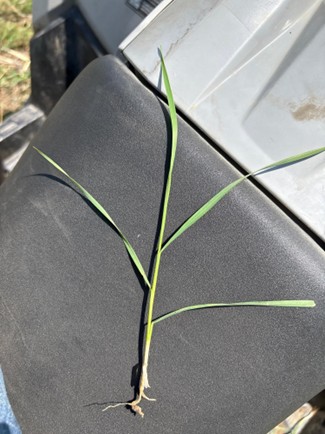
I have also had the opportunity to stage some lentil fields for a fungicide application and dig up roots to be sent in for root rot testing. I have learned about the root diseases that can affect our area.
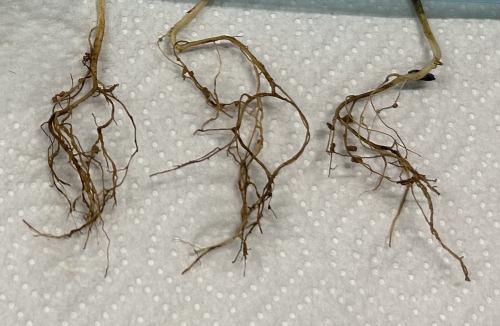
Over the summer I have gained valuable experience at Horizon Resources that will benefit me in my future career and I am excited to learn more.
Shaun Branham
Horizon Resources Agronomy Intern
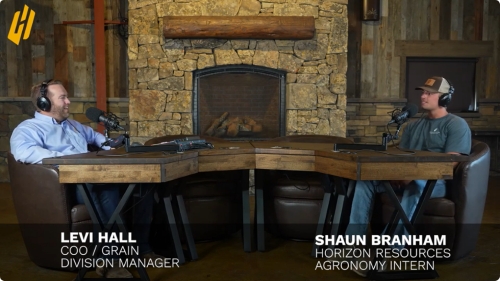
Learn more about Shaun’s experience as a summer intern with Horizon Resources in Season 2, Episode 30 of the On the Horizon podcast. We will be recruiting 2026 summer interns for our agronomy locations this winter so be sure to reach out if you or someone you know would be interested!
Armyworm in Wheat
Armyworm damage in wheat has been reported recently in the July 24th and July 31st issue of the NDSU Crop and Pest Report, and I observed severe armyworm damage in a field here locally. The armyworm larvae reduce yield by damaging foliage and clipping wheat heads.The key take-aways for Armyworm management are to determine larvae size and then select an effective product if a spray is warranted. If the larvae are large (1.5 to 2 inches long) they are done feeding and so a spray is not necessary. If the larva are small (under 1.25 inches) then feeding could continue for 3 to 4 weeks and an insecticide could reduce yield loss. Armyworms feed at night and hide in loose soil and crop residue during the day. Extension recommendations are to apply an insecticide if you find 2 or more small larvae per square foot. As we are getting close to harvest make sure to check the pre-harvest interval (PHI) of the insecticide applied. Vantacor applied at 1.2 oz/ac is effective for armyworm and has a PHI of 1 day.
Unfortunately, the armyworms in the field I scouted had grown beyond the stage where a pesticide application would be effective. Armyworm does not overwinter this far North, however, so we don’t need to be concerned that a lack of control this season will have an impact next year.
Julia Seiller
Agronomist, Fairview Location
The Bindweed Battle
As we approach pulse crop harvest, I have been having conversations with growers that are still struggling with bindweed. As this issue remains just as relevant as last fall, I am going to revisit an article from this time last year where I discussed post-harvest application of Landmaster BW. Growers that applied Landmaster BW last fall have reported success with this program.Like any other perennial weed control program, it is not a quick fix. The sheer mass of roots produced by bindweed—and its ability to regenerate from these roots—makes it a long-term challenge. If bindweed gets out of control, cleaning it up becomes a multi-year project. Unfortunately, this often results in growers putting it on the back burner, only to face the same issues when pulse crops return to the rotation.
A few weeks ago, I discussed that we have been using Landmaster BW to help out with controlling bindweed or creeping jenny, and I will explain this product a little more since we are getting close to the timing for spraying bindweed.
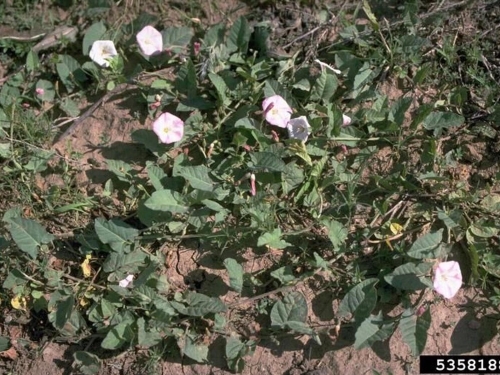
Photo credit: Howard F. Schwartz, CSU, Bugwood.org
Why Bindweed is So Tough
Bindweed is a persistent and difficult weed to control in our fields, especially once it has an established root system. It is a perennial weed that will reproduce by seed production and by rhizomes or roots. Cultivation only makes the problem worse by stimulating root growth. A plant can regrow from one inch of root left in the soil.If uncontrolled, bindweed can produce a root and rhizome mass of 2 to 5 tons per acre, concentrated in the top 1 to 2 feet of soil, but capable of extending down to 20 ft and 25 feet laterally. One plant can produce up to 500 seeds and seeds can stay viable in the soil for up to 50 years.
This weed does not just disappear, and a lot of people don’t even notice it until they raise a pulse crop and have to untangle it from their combine at harvest. Bindweed can become an absolute nightmare in a pulse crop rotation, so you need to be on top of it and try to keep it under control in your cereals.
Challenges in Pulse Crops
If you are using paraquat to desiccate your pulse crops, bindweed is a plant that you will have a tough time getting dried down. Since paraquat is strictly a contact herbicide and the target is a vine, it isdifficult getting enough water and chemical on this plant to do enough good.
For chemical weed control, we have been using a product that has been around for many years and was originally marketed by Monsanto. Landmaster BW is a combination of glyphosate and 2,4-D Amine along with their surfactant load to help get the product into the plant. I can tell you exactly how many ounces per acre of glyphosate and how many ounces of 2,4-D to spray per acre to make the equivalent of the rate we are using with Landmaster BW and it just will not work as well as Landmaster BW. Maybe if we use a high-quality surfactant like Last Chance that is similar to the surfactants used in the higher tier glyphosate products like Roundup Weathermax it might perform better, but we have not been able to duplicate the efficacy we have seen with the Landmaster BW. When Monsanto originally
marketed this product, it was targeting bindweed and that is what the BW referred to…..bindweed.
For the growers that want to keep their options open for raising a pulse crop the next year, there is no answer for you this fall that will actually kill bindweed and let you rotate to a pulse crop. Bindweed and pulse crops are just not a good combination, and you are better off raising a cereal or a crop that you can actually get some weed control in. With the high rates of 2,4-D in Landmaster BW, it is probably not a good idea to take a chance on pulse crops next spring, but with bindweed problems, pulse crops are not the best choice to begin with as it would be tough to get 100% control in one application.
Application Timing
Proper timing is essential. Creeping jenny or bindweed will dry up or brown up and will not take chemical into the plant as late as Canada Thistle will, so your want to spray Landmaster BW as soon as possible after harvest while the plant is still green and growing. That means if you have both bindweed and Canada thistle in a field you either need to pick which one you want to manage, or spot spray.This product is also labeled for preharvest in wheat, but the rates are about half of our recommended rate we are spraying post-harvest, so I don’t expect the same weed control.
If you have any questions on Landmaster BW or how to control bindweed, please contact one of our agronomists and we will get you going in the right direction.
John Salvevold, CCA
Agronomy Division Manager
Fall-Seeded Alfalfa in the MonDak Region, A Great Way to Give Your Forage Production a Head Start for 2026
As agronomic conditions in the MonDak region continue to evolve, growers are exploring opportunities to enhance forage productivity while optimizing operational timing. One strategy that deserves renewed attention is fall seeding of alfalfa. While spring has traditionally been the preferred window for establishing alfalfa, late summer to early fall seeding can offer substantial agronomic and economic advantages—particularly in our region’s unique climate and cropping systems.Why Consider Fall Seeding in the MonDak?
The MonDak’s semi-arid conditions, coupled with an increasingly tight spring workload, create an environment where fall seeding alfalfa can be strategically beneficial. Below are the primary advantages:1. Reduced Weed Competition
Fall-seeded alfalfa enjoys a significant reduction in early weed pressure compared to spring seedings. As summer annual weeds slow their growth, and soil temperatures cool, competition from kochia, foxtail, lambsquarters, and other problem species diminishes. This allows alfalfa seedlings to establish with less interference, resulting in a healthier, more uniform stand.
2. Improved Stand Establishment Conditions
Late summer and early fall seeding takes advantage of typically more stable weather conditions—less wind, fewer spring storms, and more predictable soil temperatures. Seeding in mid to late August (targeting 6 weeks before the average first killing frost) allows alfalfa to germinate in warm soils and develop a robust root system before win- ter dormancy. Here’s an example of alfalfa germinating in 70 degree soil temps vs 50 degree soil temps:

3. More Efficienty Moisture Use
Fall-seeded alfalfa can capitalize on residual summer irrigation and early fall rains. Additionally, early spring growth from fall-established alfalfa makes efficient use of stored soil moisture and snowmelt— giving it a head start over spring seedings in 2026!
4. Spring Workload Reduction
Producers in the MonDak often face a narrow window in spring to complete planting, spraying, and fertilizing across multiple crops. By seeding alfalfa in the fall, you effectively remove one more job from the spring crunch, allowing better resource allocation (equipment, labor, and time) during peak planting season.
5. First-Year Production Potential
Unlike spring-seeded alfalfa, which typically see one or two cuttings in its seeding year, fall-seeded stands are ready to produce a full first cutting by early summer of the following year. Maturity of the fall
seeded first cutting will be shortly after established alfalfa is harvested. So three cuttings are common with fall seeded alfalfa in our area. This early return on investment can significantly improve forage availability and cash flow, especially in operations with high forage demand.
Key Agronomic Considerations for Successful Fall Seeding
While the benefits are compelling, fall seeding requires proper management to ensure stand viability.1. Seeding Window
Aim to seed alfalfa at least 6–8 weeks before the average first killing frost. This ensures sufficient root development and crown formation. The goal is to have your alfalfa seeded by August 20, no later than September 1. Alfalfa can handle some light frosts, so the goal is to get the alfalfa a minimum of 6” tall or 3-4 tri-foliate leaves before a killing frost shuts it down. I’ve seen alfalfa seeded in August emerge in 72 hours after seeding, so it establishes much faster in the fall vs. spring.
2. Soil Prep
A firm, weed-free seedbed is critical. Loose, cloddy, or dry soils will compromise seed-to-soil contact and germination. A great technique is to leave small grain stubble standing (after the straw has been baled off) and direct seed into the standing stubble. This seedbed will be firm, assuring good seed to soil contact and leaving the roots intact will keep the topsoil from washing during irrigation, especially on flood irrigated fields.
3. Variety Selection
Choose winter-hardy, disease-resistant varieties bred for Northern cli- mates. Fall dormancy ratings of 3–5 and winter survival ratings of 1–2 are appropriate for our region.
Croplan is the industry leader in alfalfa and has a wide range of alfalfa varieties to fit any management scenario – baled hay, haylage, or mixed grass hay. The new AA lineup is our latest lineup with Anthracnose and Aphanomyces resistance. RR Saltiva and Nimbus 2.0 have the highest salt tolerance in the industry.
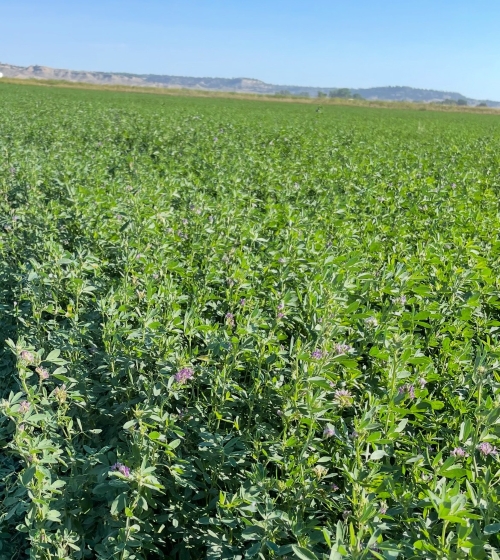
Check out this link to our varieties: www.croplan.com and if you have any questions reach out to your Horizon Resources agronomist.
Curt Droogsma, CCA .
Sales Development Manager
Winfield United
Submit Kochia Samples for Resistance Testing
It has been a challenging year for managing kochia, and while that is not entirely due to herbicide resistance, it is likely playing a significant role. Particularly in pulse crops where we rely heavily on the group 14 mode of action, to which kochia has recently developed resistance.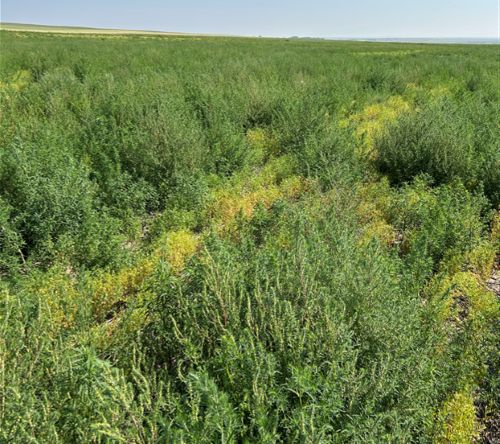
The National Ag Genotyping Center in Fargo, ND can test for glyphosate, group 14 (ex. Valor/Aim/Sharpen) and group 2 (ex. Express/Beyond) resistant kochia and this service is free for ND residents due to funding from the ND Corn Utilization Council, ND Soybean Council and the ND Dept of Ag. You can also include a green foxtail sample for an assay they are developing to detect group 1 (Tacoma/Discover/Section 3/Assure II) and group 2 (Everest) resistance.

There are free submission envelopes available from the County Extension offices or you can use the attached form to submit plants on your own. Just put the each plant into a separate envelope and mail them together along with the form to the National Ag Genotyping Center. They will test four plants per form and I would recommend collecting all four plants from the same field.
I have submitted samples from six fields so far this year and have detected group 14 resistance in four out of the six fields. Keep in mind, this is only testing four plants per field. Glyphosate resistant kochia was present in all of the fields, and group 2 resistance in all but one. One plant I submitted was resistant to all three modes of action, which is pretty scary since that seed is going to spread.
Before you desiccate your pulse crops submit samples from the kochia in your fields. Forewarned is forearmed. The test results generally come back within a week to ten days, giving you plenty of time to make fall application decisions.
Dr. Audrey Kalil
Agronomist/Outreach Coordinator
Lentil Desiccation: Dialing It in for a Smoother Harvest
Harvest season is approaching quickly—and most lentil fields aren’t going to mature evenly. That’s just the reality. Desiccation remains a key tool for a timely and efficient harvest.Why Desiccate?
Even maturity across a lentil field is rare. Without desiccation, you’ll be chasing green spots, extending your harvest window, and risking both yield and quality loss. Here's how and when to use desiccation effec- tively.Timing is Everything
Don’t rely on a drive-by inspection. Get into the field and check your plants. If the bottom third of pods have turned brown, seeds rattle in- side the pods, and the seeds are detaching from their membranes, then the field is ready for desiccation.The Go-To Herbicide: Paraquat
Paraquat (Gramoxone 3L) is the most common and effective option. It provides quick dry-down and broad weed control. The Pre-Harvest In- terval (PHI) is 7 days, but fields often appear ready before then. For consistent success, focus on three things: application timing, water volume, and adjuvants.Spray during the last few hours of daylight. Paraquat disrupts photo- synthesis and moves rapidly. Evening applications allow for deeper plant absorption and benefit from more favorable delta-T conditions, reducing evaporation and improving deposition.
Use a minimum of 15 gallons per acre. Lentils have a dense canopy, and weeds often have many growing points. Higher volumes ensure full coverage and consistent performance.
Use a Non-Ionic Surfactant (NIS) to promote droplet spread and con- tact. Not all NIS products are equal, so consult with your agronomist to choose the best option. High Surfactant Methylated Oil Concentrates (HSMOCs), which contain at least 40% NIS, have shown superior re- sults. Plain Methylated Seed Oils (MSOs) alone are less effective for paraquat.
Other Herbicide Options
If paraquat isn’t ideal for your field, consider these alternatives:
Glyphosate: A better choice when grassy or glyphosate-susceptible weeds are present. It won’t speed lentil maturity but can clean up tough weed pressure. PHI is 7 days, but expect 10 to 14 days before harvest readiness.
Sharpen (Saflufenacil): Offers quick dry-down and is effective on weeds like wild buckwheat, which paraquat may miss. PHI is just 2 days. However, it is not labeled for green lentils, which eliminates it as an option for most growers.
Valor (Flumioxazin): Strong lentil desiccant, but poor on weed con- trol. Best suited for very clean fields. Like paraquat, Sharpen and Valor both require high water volumes, end-of-day applications, and benefit from MSO-type adjuvants.
Recommended Program
For consistent and effective desiccation:- Gramoxone 3L(Paraquat): 24 oz/ac
- NIS: 32 oz per 100 gallons of water
- Water Volume: 15 GPA or more
- Application Timing: Late in the day
- PHI: 7 days
Final Word
Desiccation is more than a task—it’s a harvest management strategy. With the right timing, coverage, and tank mix, you can ensure a uni- form, efficient harvest. If you need help selecting adjuvants or building a customized desiccation plan, give us a call. We’re ready to help you finish strong.Kyle Okke, CCA
Agile Agronomy LLC
Agronomists Happy Hour Podcast
